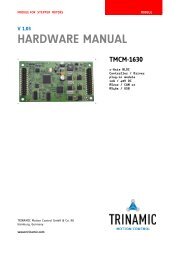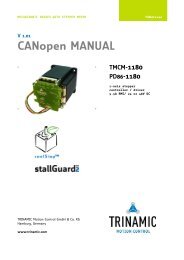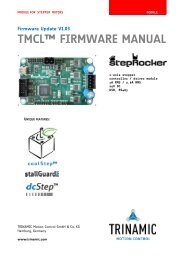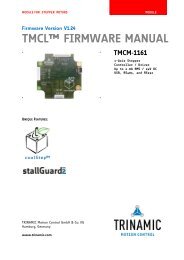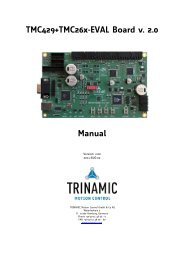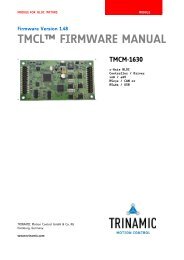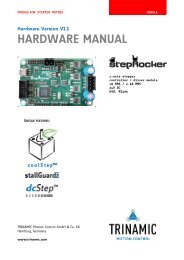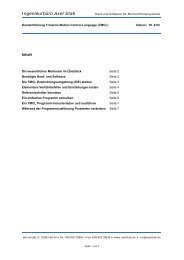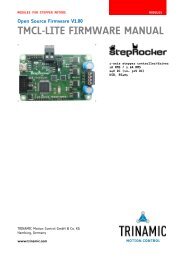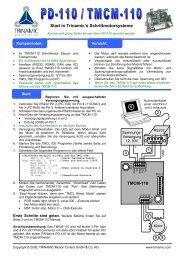1 - Trinamic
1 - Trinamic
1 - Trinamic
You also want an ePaper? Increase the reach of your titles
YUMPU automatically turns print PDFs into web optimized ePapers that Google loves.
TMCM-1110 stepRocker Hardware Manual (V1.04 / 2011-OCT-31) 14<br />
termination<br />
resistor<br />
(120 Ohm)<br />
c:><br />
Host<br />
Slave Slave Slave<br />
node<br />
1<br />
RS485<br />
Figure 4.5: RS485 bus structure<br />
Copyright © 2011, TRINAMIC Motion Control GmbH & Co. KG<br />
}<br />
node<br />
n - 1<br />
node<br />
n<br />
keep distance as<br />
short as possible<br />
termination<br />
resistor<br />
(120 Ohm)<br />
2. BUS TERMINATION:<br />
Especially for longer busses and/or multiple nodes connected to the bus and/or high communication<br />
speeds, the bus should be properly terminated at both ends. The TMCM-1110 does not integrate any<br />
termination resistor. Therefore, 120 Ohm termination resistors at both ends of the bus have to be<br />
added externally.<br />
3. NUMBER OF NODES:<br />
The RS485 electrical interface standard (EIA-485) allows up to 32 nodes to be connected to a single bus.<br />
The bus transceiver used on the TMCM-1110 units (SN65HVD3082ED) has just 1/8th of the standard bus<br />
load and allows a maximum of 256 units to be connected to a single RS485 bus.<br />
4. NO FLOATING BUS LINES:<br />
Avoid floating bus lines while neither the host/master nor one of the slaves along the bus line is<br />
transmitting data (all bus nodes switched to receive mode). Floating bus lines may lead to<br />
communication errors. In order to ensure valid signals on the bus it is recommended to use a resistor<br />
network connecting both bus lines as well defined logic levels. In contrast to the termination resistors<br />
this network is normally required just once per bus. Certain RS485 interface converters available for PCs<br />
already include these additional resistors (e.g. USB-2-485).<br />
4.5.2 USB<br />
RS485+ / RS485A<br />
RS485- / RS485B<br />
Slave Slave<br />
node<br />
n - 1<br />
node<br />
n<br />
+5V<br />
GND<br />
Figure 4.6: RS485 bus lines with resistor network<br />
pull-up (1k)<br />
pull-down (1k)<br />
termination<br />
resistor<br />
(120 Ohm)<br />
For remote control and communication with a host system the TMCM-1110 stepRocker provides a USB 2.0 fullspeed<br />
(12Mbit/s) interface (mini-USB connector). As soon as a USB-Host is connected the module will accept<br />
commands via USB. The TMCM-1110 support USB self powered operation (when an external power is supplied<br />
via the power supply connector) and USB bus powered operation, also (no external power supply via power<br />
supply connector). During USB bus powered operation, only the core digital circuit parts will be operational.<br />
That is, the microcontroller itself and also the EEPROM. Motor movements will not be possible. This mode has<br />
been implemented in order to enable configuration / parameter setting / read-out, firmware updates etc. by just<br />
connecting a USB cable between the module and a host PC. No additional cabling / external devices as e.g.<br />
power supply etc. are required in that case.



